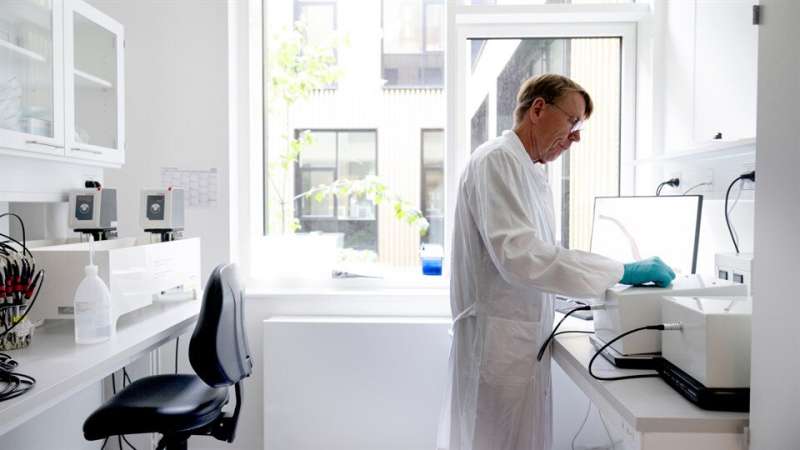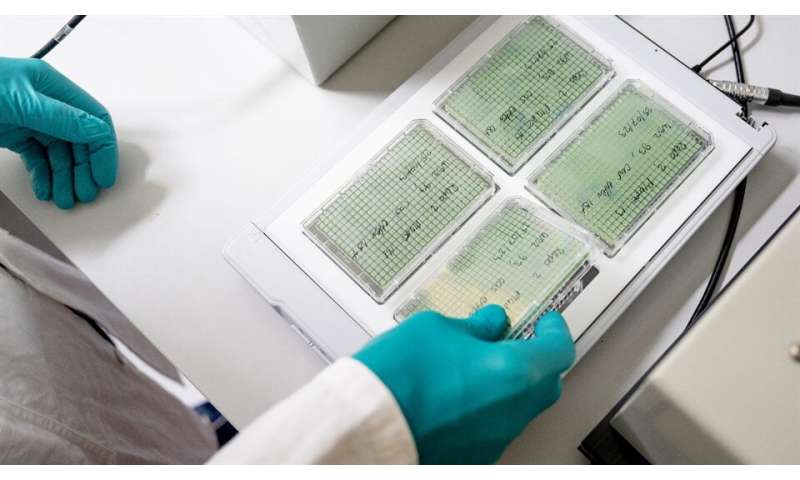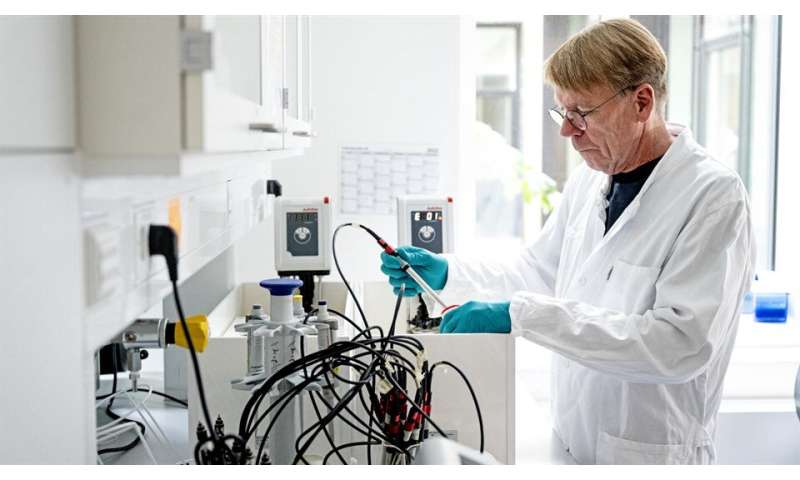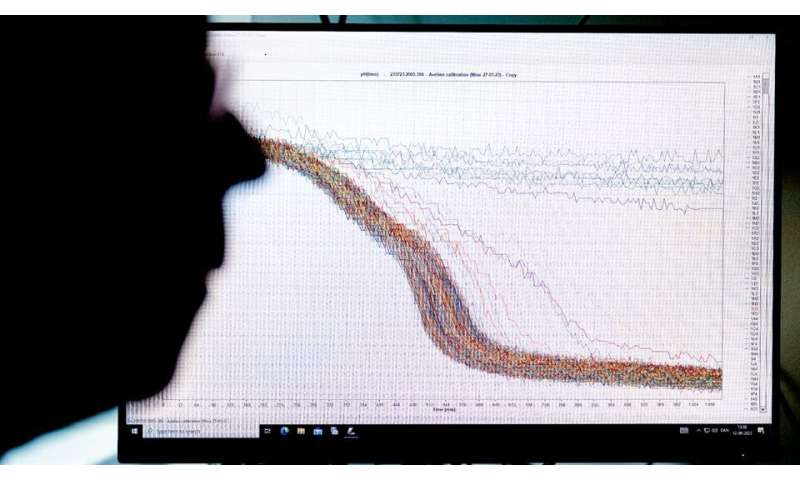This article has been reviewed according to Science X's editorial process and policies. Editors have highlighted the following attributes while ensuring the content's credibility:
fact-checked
trusted source
proofread
Can buttermilk help cure infection from flesh-eating bacteria?

In spring 2023, Egon Bech Hansen received a much-awaited small, square package from the United States. The package contained nine plastic plates with 3,456 small wells.
At first glance, the plates looked empty, but holding them up to the light, he could see scattered small red or blue blobs, indicating that something was hiding in the wells. Each well contained 0.1 microliters (typically equal to 0.5 millionth of a gram) of an approved pharmaceutical, and the plates were to help Egon Bech Hansen test a surprising correlation: that buttermilk can be used to fight flesh-eating bacteria.
Beneficial and harmful streptococci
You may be aware that your breakfast yogurt contains millions of probiotic bacteria that are healthy for your gut. But what you may not know is that the beneficial bacterium of yogurt is called Streptococcus thermophilus and that it is related to the type of streptococcus that can cause sore throat, scarlet fever, impetigo, and erysipelas—namely Streptococcus pyogenes—also known as group A streptococcus.
This type of streptococcus may become invasive and enter the blood, where they produce special toxins that create blood clots in the small blood vessels and necrotize the tissue. Therefore, they have been given the term flesh-eating bacteria, and although this is a rare infection, it may be life-threatening because it develops very quickly and can destroy 5–10 centimeters of tissue per hour.
The treatment consists of high doses of antimicrobial agents in the blood stream or surgery to remove the dead tissue, but it is often necessary to amputate arms or legs to prevent the infection from spreading. Still, up to one in four people infected with flesh-eating streptococcus die.
Scanner sees new correlations
The relationship between the two types of bacteria is well known. Nevertheless, it surprised Egon Bech Hansen, Professor at DTU Food, that an enzyme that enables lactic acid bacteria to acidify milk bore great similarity to an enzyme that enables the flesh-eating bacteria to deactivate the immune system.
A few years ago, he modeled the structure of the enzyme from a buttermilk bacterium and realized how similar it was to the enzyme in group A streptococcus. He was not the first to discover this, but no one had figured out how to translate this knowledge into a method for fighting the flesh-eating bacteria. But then a scanner entered Egon Bech Hansen's laboratory.
The scanner is an ordinary Epson office scanner costing DKK 700, which is sensitive enough to detect color changes in bacterial cultures. So Egon Bech Hansen and a student assistant took the purchased plastic plates with 3,000 pharmaceuticals and made a mixture of lactic acid bacteria, skimmed milk as a culture medium, and a pH indicator, which they placed in the plastic wells.
They then put them on the scanner under a lid that kept the temperature at 30 degrees, giving the lactic acid bacteria favorable conditions for multiplying. The pH indicator changed color if the bacteria acidified the milk, enabling them to pinpoint the wells containing a pharmaceutical that prevented the acidification process. The scanner detected the acidification in all 3,000 wells and Egon Bech Hansenit found the result exciting—his method seemed to be working.
When Egon Bech Hansen sees enzymes, he sees beauty. Having researched enzymes for 40 years, he finds that they are beautiful in themselves, but he also sees correlations which have pulled his normal expertise in foods such as camel milk and yogurt in a new direction that incorporates clinical treatment.
A protease (enzymes that break down protein) grows on the outside of the streptococcal bacterium. In yogurt, the protease cleaves some of the milk's proteins, allowing the bacterium to grow and convert milk sugar into lactic acid. Group A streptococcus exploit a similar enzyme to cleave signaling molecules from the body's immune system, thereby avoiding that the infection-fighting immune cells are alerted.
"The bacteria become invisible to the body, so they can necrotize the tissue as they please," explains Egon Bech Hansen.
-

The plates with pharmaceuticals in each of the small wells are placed on the scanner. Egon Bech Hansen has added skimmed milk inoculated with a bacteria—the milk is colored blue by a pH indicator. When the milk sours, it changes color to greenish and the wells where the color is still blue indicates that the substance inhibits the acidification. Credit: Bax Lindhardt -

Before using the scanner, Egon Bech Hansen used a so-called pH electrode to register whether the milk soured. The setup with 16 electrodes takes up more space than the scanner with 4 x 386 wells. It would take 100 days to complete a similar experiment with pH electrodes—and would require much larger amounts of material. Credit: Bax Lindhardt -

The scanner registers the color of each of the small wells and then graphs are calculated that show the extent to which each drug sours the milk. Credit: Bax Lindhardt
Handful of promising candidates
His experiments revealed that a handful of the 3,000 pharmaceuticals inhibit the protease that enables lactic acid bacteria to acidify milk. And as the enzymes in benign and malignant streptococci are so similar, he convinced researchers at the University of Limerick in Ireland who specialize in analyzing bacterial protease to test whether these substances could inhibit the enzyme from Streptococcus pyogenes.
Six of the substances could, and hopefully some of them can be used to deactivate the enzyme and make the streptococcal bacteria visible to the immune system, so that the body itself will be able to fight the flesh-eating bacteria.
"There is no guarantee that it will work, but we've found some good candidates," says Egon Bech Hansen and continues:
"What's so exciting is that it's a whole new way of treating infections. If we do a test on an agar plate to determine whether these pharmaceuticals inhibit the bacterium, nothing happens, because there is no immune system on an agar plate. So they aren't antibiotic in the classical sense. But we make sure that the immune system detects the bacteria and hopefully fights the infection itself."
The preliminary results are so promising that DTU has applied for a patent for Egon Bech Hansen's screening method. In order to extend the list of candidates, Egon Bech Hasen is screening an additional 10,000 pharmaceuticals, including medicines that have not yet been launched on the market. The candidates will then be analyzed further at the University of Limerick, where the researchers will study whether the pharmaceuticals have also inhibited the so-called virulence factor of streptococcal bacteria, which makes the bacterium pathogenic.
Saving lives
Although invasive group A streptococcus is a relatively rare infection, it is estimated that it kills 150,000 people worldwide every year. In Denmark, there are about 150 cases a year on average, but this year has seen a streptococcal epidemic where the number of cases has been 3–4 times higher than normal. From November to July, as many as 76 people died from invasive group A streptococcus, according to Statens Serum Institut (SSI), whereas the number is normally 20–25 annually. SSI concludes that the drastic increase is due to a new variant of group A streptococcus and reduced immunity following the coronavirus lockdown.
Other countries such as France, Ireland, the Netherlands, Sweden, and the U.K. have also seen a sharp increase in the number of cases of invasive group A streptococcus during the winter.
Egon Bech Hansen hopes that his discovery can help save human lives. He envisages that it will be possible to give the drug preventively to vulnerable groups such as children and the elderly, when, for example, they have a dirty wound and risk developing a streptococcal infection.
Faster market launch
If it turns out that an existing pharmaceutical can knock out the enzyme in the streptococcal bacterium, Egon Bech Hansen estimates that a treatment could be developed within just a few years.
"If we find that an approved pharmaceutical, such as a headache tablet, can prevent streptococci from becoming necrotizing, it should be faster to get it onto the market," says Egon Bech Hansen.
However, the challenge is that the development of pharmaceuticals for treatment of rare infections is not necessarily a lucrative business for pharmaceutical companies, and they will therefore be reluctant to conduct further research into this. But this does not discourage Egon Bech Hansen.
"I'm pretty confident that if we obtain funding to continue the research, we will be able to find a treatment," he says.



















